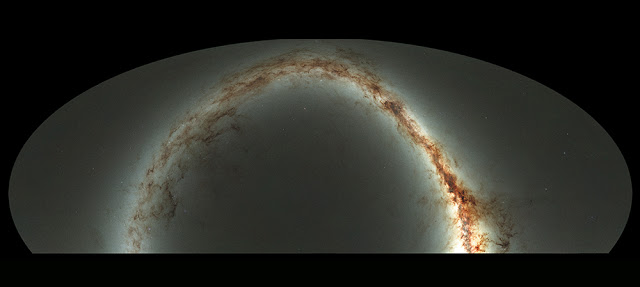

| Online: | |
| Visits: | |
| Stories: |

| Story Views | |
| Now: | |
| Last Hour: | |
| Last 24 Hours: | |
| Total: | |
Largest Digital Sky Survey Released by Pan-STARRS
The Pan-STARRS project at the University of Hawaii Institute for Astronomy is publicly releasing the world’s largest digital sky survey via the Space Telescope Science Institute (STScI) in Baltimore, Maryland.
“The Pan-STARRS1 Surveys allow anyone to access millions of images and use the database and catalogs containing precision measurements of billions of stars and galaxies,” said Dr. Ken Chambers, Director of the Pan-STARRS Observatories. “Pan-STARRS has made discoveries from Near Earth Objects and Kuiper Belt Objects in the Solar System to lonely planets between the stars; it has mapped the dust in three dimensions in our galaxy and found new streams of stars; and it has found new kinds of exploding stars and distant quasars in the early universe.”
This compressed view of the entire sky visible from Hawaii by the Pan-STARRS1 Observatory is the result of half a million exposures, each about 45 seconds in length, taken over a period of 4 years. The shape comes from making a map of the celestial sphere, like a map of the Earth, but leaving out the southern quarter. The disk of the Milky Way looks like a yellow arc, and the dust lanes show up as reddish brown filaments. The background is made up of billions of faint stars and galaxies. If printed at full resolution, the image would be 1.5 miles long, and you would have to get close and squint to see the detail.
The four years of data comprise 3 billion separate sources, including stars, galaxies, and various other objects. The immense collection contains 2 petabytes of data, which is equivalent to one billion selfies., or one hundred times the total content of Wikipedia.
The first Panoramic Survey Telescope & Rapid Response System (Pan-STARRS) observatory is a 1.8-meter telescope at the summit of Haleakalā, on Maui. In May 2010, it embarked on a digital sky survey of the sky in visible and near infrared light. This was the first survey to observe the entire sky visible from Hawaii multiple times in many colors of light, with the goal of finding moving, transient, and variable objects, including asteroids that could potentially threaten the Earth. The survey took approximately four years to complete, and scanned the sky 12 times in each of five filters.
Credit: University of Hawai‘i News
This research program was undertaken by the PS1 Science Consortium — a collaboration among 10 research institutions in four countries with support from NASA and the National Science Foundation (NSF). Consortium observations for the sky survey, mapping everything visible from Hawaii, were completed in April 2014. This data is now being released publicly.
“It’s great to see the Pan-STARRS1 data release supported by the National Science Foundation (NSF) now made available to the general astronomical community,” said Nigel Sharp, program director in NSF’s astronomical sciences division. “I am impressed by the work the team invested to make the best-calibrated and best-characterized data set they could. I eagerly anticipate the science from mining these data.”
The roll-out is being done in two stages. The release is the “Static Sky,” which is the average of each of those individual epochs. For every object, there’s an average value for its position, its brightness, and its colors. In 2017, the second set of data will be released, providing a catalog that gives the information and images for each individual epoch.
The Space Telescope Science Institute provides the storage hardware, the computers that handle the database queries, and the user-friendly interfaces to access the data.
“The cooperation between STScI and the Pan-STARRS team at the University of Hawaii has been essential to ensuring that this initial data release is successful,” explained Dr. Marc Postman, Head of the Community Missions office at STScI, and liaison between STScI and the PS1 Consortium. “STScI was a natural partner to host the Pan-STARRS public archive given its extensive experience serving astronomy data to the international community. In advance of the release of the Pan-STARRS data, STScI staff helped perform checks of data quality, helped write archive user documentation, tested and installed the local data storage and database query system, and designed, built and deployed the web-based user interfaces to the archive system.”
The survey data resides in the Mikulski Archive for Space Telescopes (MAST), which serves as NASA’s repository for all of its optical and ultraviolet-light observations, some of which date to the early 1970s. It includes all of the observational data from such space astrophysics missions as Hubble, Kepler, GALEX, and a wide variety of other telescopes, as well as several all-sky surveys. Pan-STARRS marks the nineteenth mission to be archived in MAST.
The data can be accessed at http://panstarrs.stsci.edu.
Dr. Kenneth Chambers
The Pan-STARRS1 Surveys
K. C. Chambers et al
https://arxiv.org/abs/1612.05560
Pan-STARRS Data Processing System
Eugene A. Magnier et al
https://arxiv.org/abs/1612.05240
Pan-STARRS Pixel Processing: Detrending, Warping, Stacking
C. Z. Waters et al
https://arxiv.org/abs/1612.05245
Pan-STARRS Pixel Analysis : Source Detection & Characterization
Eugene A. Magnier et al
https://arxiv.org/abs/1612.05244
Pan-STARRS Photometric and Astrometric Calibration
Eugene. A. Magnier et al
https://arxiv.org/abs/1612.0524
The Pan-STARRS1 Database and Data Products
H. A. Flewelling et al
https://arxiv.org/abs/1612.05243
Source:



